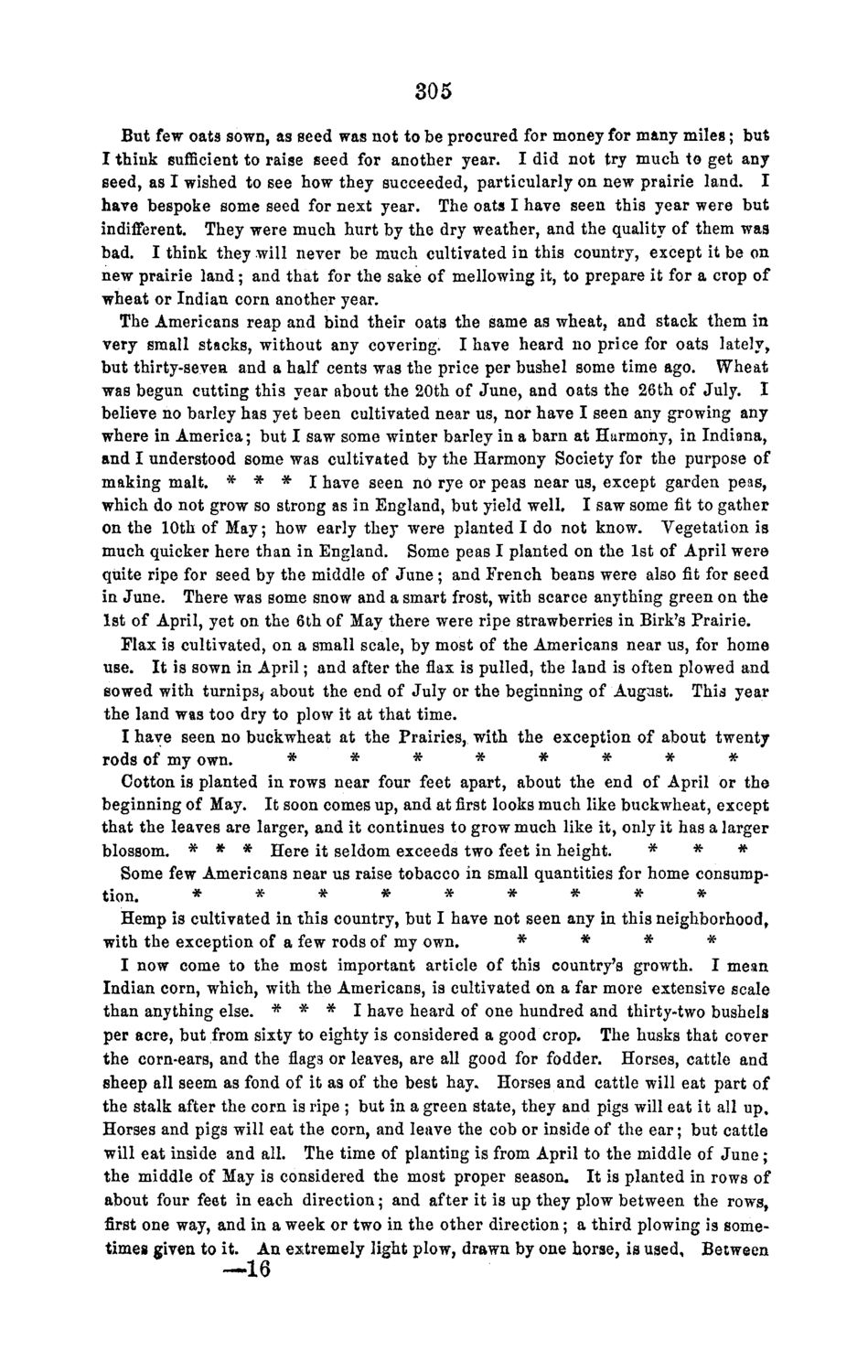| |
| |
Caption: Board of Trustees Minutes - 1868
This is a reduced-resolution page image for fast online browsing.

EXTRACTED TEXT FROM PAGE:
305 But few oats sown, as seed was not to be procured for money for many miles; but I think sufficient to raise seed for another year. I did not try much to get any seed, as I wished to see how they succeeded, particularly on new prairie land. I have bespoke some seed for next year. The oats I have seen this year were but indifferent. They were much hurt by the dry weather, and the quality of them was bad. I think they will never be much cultivated in this country, except it be on new prairie land; and that for the sake of mellowing it, to prepare it for a crop of wheat or Indian corn another year. The Americans reap and bind their oats the same as wheat, and stack them in very small stacks, without any covering. I have heard no price for oats lately, but thirty-seven and a half cents was the price per bushel some time ago. Wheat was begun cutting this year about the 20th of June, and oats the 26th of July. I believe no barley has yet been cultivated near us, nor have I seen any growing any where in America; but I saw some winter barley in a barn at Harmony, in Indiana, and I understood some was cultivated by the Harmony Society for the purpose of making malt. * * * I have seen no rye or peas near us, except garden peas, which do not grow so strong as in England, but yield well. I saw some fit to gather on the 10th of May; how early they were planted I do not know. Vegetation is much quicker here than in England. Some peas I planted on the 1st of April were quite ripe for seed by the middle of June ; and French beans were also fit for seed in June. There was some snow and a smart frost, with scarce anything green on the 1st of April, yet on the 6th of May there were ripe strawberries in Birk's Prairie. Flax is cultivated, on a small scale, by most of the Americans near us, for home use. It is sown in April; and after the flax is pulled, the land is often plowed and sowed with turnips, about the end of July or the beginning of August. This year the land was too dry to plow it at that time. I have seen no buckwheat at the Prairies, with the exception of about twenty rods of my own. * * * * * * * * Cotton is planted in rows near four feet apart, about the end of April or the beginning of May. It soon comes up, and at first looks much like buckwheat, except that the leaves are larger, and it continues to grow much like it, only it has a larger blossom. * * * Here it seldom exceeds two feet in height. * * * Some few Americans near us raise tobacco in small quantities for home consumption, * * * * * * * * * Hemp is cultivated in this country, but I have not seen any in this neighborhood, with the exception of a few rods of my own. * * * * I now come to the most important article of this country's growth. I mean Indian corn, which, with the Americans, is cultivated on a far more extensive scale than anything else. * * * I have heard of one hundred and thirty-two bushels per acre, but from sixty to eighty is considered a good crop. The husks that cover the corn-ears, and the flag3 or leaves, are all good for fodder. Horses, cattle and sheep all seem as fond of it as of the best hay. Horses and cattle will eat part of the stalk after the corn is ripe ; but in a green state, they and pigs will eat it all up. Horses and pigs will eat the corn, and leave the cob or inside of the ear; but cattle will eat inside and all. The time of planting is from April to the middle of June; the middle of May is considered the most proper season. It is planted in rows of about four feet in each direction; and after it is up they plow between the rows, first one way, and in a week or two in the other direction; a third plowing is sometimes given to it. An extremely light plow, drawn by one horse, is used. Between —16
| |